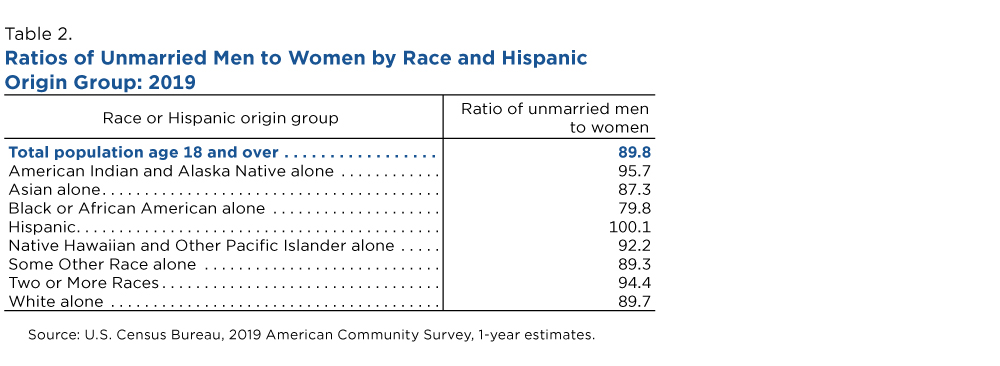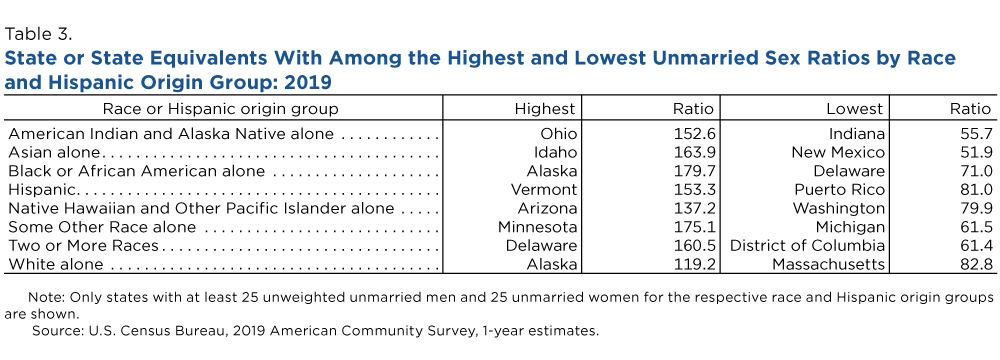All the Single Ladies: Washington, D.C., Has the Highest Ratio of Unmarried Women to Unmarried Men
The odds of finding a potential mate in the United States were in men’s favor in 2019; there were 89.8 unmarried men for every 100 unmarried women, according to a new U.S. Census Bureau analysis.
Although the overall sex ratio for unmarried adults in the United States was about 90 men per 100 women, the 30-to-34 age group had the highest ratio at nearly 121 men to 100 women.
In this article, the unmarried population includes people age 18 and over who were never married, widowed or divorced, regardless of their sexual orientation.
Go to the nation’s capital, Washington, D.C., for one of the lowest ratios of unmarried men to women: 80 unmarried men for every 100 unmarried women. Head north to Alaska to find the opposite: 117 available men for every 100 women.
Ratios of unmarried men to women matter because people interested in romantic partnerships select from a pool of eligible candidates available to them, often called a “marriage market.” The more eligible partners in a given market, the better the chances of forging a romantic partnership or marriage.
Although the ratio of unmarried men to women isn’t the only factor that affects finding a mate, it is a critical indicator of potential mate availability among those interested in opposite-sex partners.
There is considerable variation in these unmarried ratios by state, age and race and Hispanic origin.
A new data visualization recently released by the Census Bureau highlights these differences and allows users to customize the data by each field of interest.
Where the Odds of Finding Potential Mates Are Highest
Geographic variation in marriage patterns has been studied extensively, and the employment, income and education profiles of adults may differ across specific marriage markets. For example, research has shown that men who are employed, have higher incomes and are college-educated are more attractive in the marriage market.
States or state equivalents with among the five highest and the five lowest unmarried sex ratios show where unmarried men outnumber women and vice versa (Table 1). Ratios greater than 100 indicate more unmarried men than women, while ratios less than 100 indicate more unmarried women than men.
Ratios of Unmarried Men to Women by Race and Hispanic Origin
Comparing ratios by race and Hispanic origin reveals even more complexity.
Racial and ethnic intermarriage [PDF 2.4 MB] and cohabitation [PDF 3.4 MB] are becoming more common nationwide but most adults still tend to marry within their racial and ethnic group [PDF <1.0 MB]. A contributing factor to this variation is that among race and Hispanic origin groups, the population is not evenly distributed across states.
At the national level, the unmarried sex ratio by race and Hispanic origin ranged from 79.8 for the Black or African American alone population to 100.1 for the Hispanic population (Table 2).
Table 3 shows the states that had among the highest and lowest unmarried sex ratios for each race and Hispanic origin group.
For example, there were around 180 unmarried Black or African American men per 100 unmarried Black or African American women in Alaska. Conversely, for the Asian alone population, there were only about 52 unmarried men per 100 unmarried women in New Mexico.
Ratios of Unmarried Men to Women by Age
Although the overall sex ratio for unmarried adults in the United States was about 90 men per 100 women, the 30-to-34 age group had the highest ratio at nearly 121 men to 100 women. This is likely due to men having a higher median age at first marriage (30.1) than women (28.2). In other words, because men typically marry later, on average, there are more of them available to marry at younger ages.
This pattern reverses at older ages, but likely for a different reason. The 55-and-over age group had the lowest unmarried ratio, with approximately 57 men per 100 women. This is likely driven by a shorter life expectancy for men than women, which produces disproportionately high counts of unmarried women at older ages — many who may be single simply because they outlived their spouse.
Labor Markets Affect the Pool of Unmarried Men and Women
Location was also an important factor across age groups (Table 5). Characteristics such as differences in local labor markets can influence sex ratios across geographies.
For example, states with large industries that employ more men or women can tilt sex ratios in one direction or the other (e.g., a state with strong mining, oil or construction industries may attract more men). States with a large military population may also tilt sex ratios toward men, since the majority of active duty military are men.
This may be why a state like Alaska, dominated by industries that tend to employ mainly men, had among the highest unmarried sex ratios for the 18-to-24, 45-to-54, and 55-and-over age groups.
To explore the data visualization, click on the image below.
Note: Select the image to go to the interactive data visualization.
Related Statistics
-
Stats for StoriesUnmarried and Single Americans Week: September 17-23, 2023In 2022, about 132.3 million or 49.3% of Americans age 15 and over were unmarried, according to the Current Population Survey.
-
Stats for StoriesSingles Awareness Day: February 15, 2024The 2022 Annual Social and Economic Supplement estimated there were 132.3M unmarried (never married, divorced and widowed) people in the U.S. ages 15 and older.
-
Stats for StoriesNational Single Parent Day: March 21, 2024The Current Population Survey (CPS) estimates there were 9.8M one-parent households (7.3M mother only and 2.5M father only) in 2023, compared to 1.5M in 1950.
-
American Community Survey (ACS)The American Community Survey is the premier source for information about America's changing population, housing and workforce.
Subscribe
Our email newsletter is sent out on the day we publish a story. Get an alert directly in your inbox to read, share and blog about our newest stories.
Contact our Public Information Office for media inquiries or interviews.
-
Families and Living ArrangementsNational Marriage and Divorce Rates Declined From 2011 to 2021July 13, 2023Puerto Rico had among the lowest marriage and divorce rates in 2021.
-
Families and Living ArrangementsDoes Marrying Younger Mean Marrying More Often?August 31, 2022The age at first marriage can affect the number of times you get married.
-
Families and Living ArrangementsMarriage Prevalence for Black Adults Varies by StateJuly 19, 2022While the United States as a whole saw a 1.9 percentage-point decrease in married Black adults, four states experienced a significant increase.
-
PopulationWhich States Had the Highest Shares of Newcomers?April 29, 2025Many states with the highest share of recent movers from out-of-state in 2023 had relatively small populations.
-
Business and EconomyEntertainment, Travel, and Recreation Industries ReboundingApril 23, 2025A look at which selected travel, entertainment and recreation-related industries hit hard by the pandemic rebounded.
-
Income and PovertyNew Snapshots From the Survey of Income and Program ParticipationApril 21, 2025New Census Bureau product offers mobile-friendly fact sheets on who receives income from various sources.
-
PopulationU.S. Metro Areas Experienced Population Growth Between 2023 and 2024April 17, 2025New Census Bureau population estimates show 88% of U.S. metro areas gained population between 2023 and 2024.












